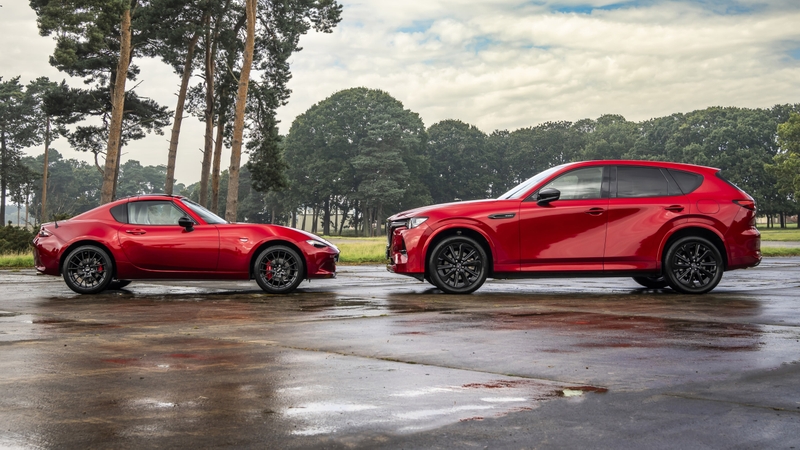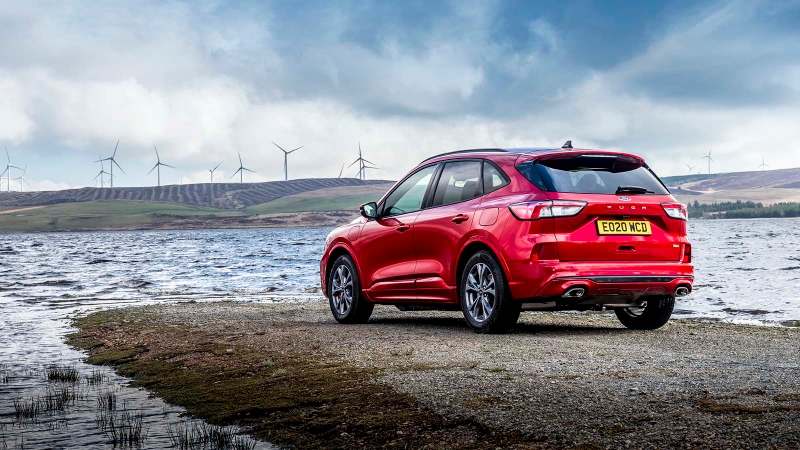














Mazda CX-5 Review
The Mazda CX-5 has its work cut out to compete against a huge number of talented rivals including the Hyundai Tucson, Volkswagen Tiguan and Kia Sportage.
Luckily, Mazda’s attempt has plenty in its arsenal. Behind its smart styling lies a grown-up interior, neat handling and decent practicality.
- Premium interior feel
- Decent rear-seat space
- Well equipped
- Uninspiring engine range
- No hybrid option
- Rivals have bigger boots
Should I buy a Mazda CX-5?
Walk past the usual midsize SUV suspects and you might find yourself at the Mazda CX-5. You’ll be taking in its handsome looks, with slim headlights almost reminiscent of the MX-5 sports car and a recessed grille that makes the car look like it’s moving even when it’s stood still.
The CX-5 is a worthy opponent to the likes of the Ford Kuga, Nissan Qashqai, Volkswagen Tiguan and Kia Sportage, and not just in the looks department. Its sophisticated interior boasts posh materials and lots of tech – even if it doesn’t look like it at first glance – and it’s easily big enough for family clutter, dogs or bulky hobby equipment.
Another CX-5 calling card is the fact it drives much better than it needs to. This is an SUV that still knows how to entertain you, welcoming you into the driving experience rather than isolating you from it. It’s not fast, but it corners nicely and feels sporty – and not at the expense of comfort, either.
While the traditional petrol and diesel engines are fine, the CX-5’s appeal would be broadened if it had a hybrid or plug-in hybrid option. Even the clever e-Skyactiv X engine that’s fitted to the Mazda 3 and CX-30 – which is quick and economical – would be a great addition to the CX-5 lineup.
Interior and technology

The CX-5 is the perfect antidote if you think modern cars are too screen-obsessed and tech-heavy. It has all the features you’d find in a BMW or Audi, but everything’s displayed in a classy way that’s not too in-your-face. There is a digital driver’s display in the dials, but it’s mainly used to show an analogue dial and the trip computer info.
Likewise, the infotainment screen isn’t a touchscreen. Instead, it’s controlled by dials and buttons by the gearlever. A touchscreen is distracting, takes your eyes off the road for longer than is necessary and can be hard to hit while driving. Once you’ve got used to using the ‘Multimedia Commander’ – which won’t take long – you’ll find it easy to get to the menu screen you want without any fuss.
There are buttons for the climate control and steering wheel functions, too. All the controls feel solid and tactile, and you’ll appreciate how easy everything is to use in day-to-day life.

Some people call Mazda the Japanese BMW, partly because its cars are fun to drive and partly thanks to the quality interiors the brand produces. Even though it’s starting to feel its age, the CX-5 still has a premium cabin with plush materials and excellent build quality. There’s a lot of leather and chrome, too.
And a lot of standard equipment. Every CX-5 gets Apple CarPlay and Android Auto – which connects wirelessly in recent models – plus sat nav, two-zone climate control, parking sensors, and LED headlights. You also get a full suite of driver assistance features, including rear cross traffic alert, blind-spot monitoring, auto high-beam and lane-keep assist.
You don’t have to go very far up the range to add eye-catching 19-inch wheels and heated leather seats. Mid- and high-spec models pile on the kit, giving the CX-5 a proper luxury car list of equipment.
Practicality

The CX-5 is the Mazda to go for if you need a decent amount of space. It’s competitive with most of its midsize SUV rivals – the 525-litre boot is a few litres up on the Vauxhall Grandland, SEAT Ateca and BMW X1, but a little short of the VW Tiguan and Hyundai Tucson.
The boot is a really useful shape and there’s only a small load lip to worry about, which’ll appeal if you have to heave heavy items like pushchairs or poodles into the loadbay. There are release levers for the individually folding rear seats, a couple of useful hooks and a parcel shelf that’s attached to the bootlid so it rises out of the way when you open the boot. Or when the car opens it, if you choose a mid or high-spec model with an electrically opening tailgate.
Storage space in the cabin is decent as well. There’s a good sized glovebox and a cubby in the centre armrest, and the door bins are now large enough to fit more than a single bottle of water. However, the low climate controls mean the phone tray ahead of the gearlever isn’t very large, so certain devices might not fit.

Your passengers should fit in the rear seats, though. The back-seat space is generous enough, with good amounts of headroom and legroom – only very tall adults will struggle to fit in. Seating three adults across the rear bench is doable but, like the majority of the CX-5’s rivals, the middle-seat passenger will feel very cramped. You get map pockets, air vents and a fold-down armrest. A minor gripe is that we’d like the Isofix points to be more easily accessible.
Engines and performance
One for the traditionalists – the Mazda CX-5 only comes with petrol or diesel engines. Mazda has fitted mild-hybrid tech to more recent petrol models for a slight reduction in CO2 emissions, but you’ll struggle to notice the electrical assistance unless you’re actively looking out for it.
We’d recommend the 2.0-litre petrol engine to most buyers. It’s a highly reliable engine, capable of racking up tens of thousands of miles with just routine servicing and maintenance. The lack of a turbocharger makes the engine simpler so there’s less to go wrong. The flipside of that is that the 165hp engine sometimes feels underpowered, and you’ll need to stay in gears for longer than you would in turbocharged rivals.

There’s also a 2.5-litre petrol engine. It’s limited to the very top-spec trim level and only comes with an automatic gearbox and four-wheel drive, so it’s a rare choice.
The petrols don’t really stand out for either performance or economy – the official figures are 43mpg for the 2.0-litre engine with a manual gearbox (40mpg with the auto) and 37mpg for the 2.5. We’d expect around 35mpg in the real world from both, which is not too bad but not great either. The 2.0-litre engine takes 10.7 seconds to go from 0-62mph, and the bigger engine only knocks about a second off that time.
If you do regular long journeys, the 2.2-litre diesel engine can officially scrape 50mpg. Previously offered with 148hp and 181hp, it’s now only available in the higher output. Zero-to-62mph takes around 9.5 seconds. A manual or automatic gearbox is available, and four-wheel drive is also an option with this engine. Make sure to read our guides to DPFs and AdBlue if you’re considering a diesel engine.
The diesel is the obvious choice for customers wanting to tow. Every 181hp diesel can tow 2,000kg and, while so can some of the petrol engines, the diesel offers much more low-down pulling power that makes it easy to get moving with a caravan on the back.
Driving and comfort

Luckily, the CX-5 drives well enough that you can probably overlook its underwhelming engines. The steering is a particular highlight, feeling well weighted and natural – rather than vague and overly light setups favoured by most SUVs.
Body roll is mostly absent, allowing a keen driver to take a sweeping corner a bit faster than many rival SUVs. The suspension setup is firm to allow this, but the CX-5 is still comfortable. It’s well damped, too, settling down quickly after big jolts and spotty patches of asphalt.
We’d recommend picking the manual gearbox if you can, as it has a lovely shift action. The automatic gearbox can be a little slurred at times, and occasionally needed to be a bit smoother.
Only the Ford Kuga and SEAT Ateca can compete with the Mazda’s keen handling, so they’re also worth checking out if you want a family car with flair.

































































